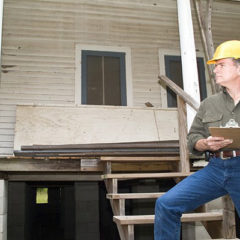How to Get Rid of Mold From Every Home Surface area
Mold spores are all over https://en.search.wordpress.com/?src=organic&q=Mold inspection around us in every type of environment. Mold is fungi and some types are very beneficial to mankind (consider penicillin), while others can be rather dangerous to crops, respiratory systems, and the stability of structures. Hazardous find a mold inspector near me - www.precisionenviro.net/ Mold vs. Mildew The most typical type of mold found in homes is mildew.
Mildew is a surface mold that grows in warm, wet locations like your bathroom and on materials and books saved in wet basements. Mildew starts as a gray or white grainy nest. It will turn black or brown if not eliminated promptly and frequently looks like soil build-up. To check if the surface is covered with mildew or simply dirt, dab the stain with a cotton bud dipped in home chlorine bleach. If the stain lightens or vanishes after 2 or three minutes, it's mildew. If not, it's most likely simply dirt. If you spot a moldy odor anywhere in your home, then you have a high concentration of mold. It can be coming from an obstruct filled with moist towels, from a moist crawlspace under your house, or carpets that have mold growing in the padding. It's absolutely time to act to get rid of the problem. Now you know that all mildew is mold however not all molds are mildew.
Mildew can tarnish and slowly damage surface areas but there are far more harmful molds that can harm the structure of your home. If you see a black or green mold that is fuzzy or slimy and the drywall or wood below is soft or falls apart, there is irreparable rot and the mold and the broken surface areas should be gotten rid of instantly.
Employing Specialists If mildew problem is caught early, you can quickly manage it with home cleaners.
Caution For extensive mold issues, consider working with an expert. Some molds are extremely harmful and even less hazardous molds can trigger issues for anybody with mold allergic reactions or compromised breathing systems. The rule of thumb is if the more information here mold covers 10 or more square feet, contact a professional. Getting rid of large mold colonies needs direct exposure to heavy-duty chemicals and correct disposal of plagued building products.
Local public health departments can offer guidance on mold screening and refer you to a specialist mold remover.
Products That Eliminate Mold Chlorine bleach: Sodium hypochlorite or regular household bleach works best to damage mold and eliminate any discoloration. It is quite harsh and must be watered down prior to utilizing.
Warning Care need to be used due to toxicity and dangerous fumes and bleach needs to never ever be integrated with ammonia.
Hydrogen peroxide: Less extreme than chlorine bleach, hydrogen peroxide (three to 10 percent service) will eliminate mold and lighten stains. While it does have a whitening effect, it works more gradually than chlorine bleach but has no hazardous fumes or residue.
Distilled white vinegar: Vinegar is acidic and gradually breaks down the structure of mold and kills it. Vinegar is non-toxic however mold stains might stay and extra scrubbing with a home cleaner might be needed.
Sodium bicarbonate and borax: Salt bicarbonate (baking soda) and borax each have a high pH that inhibits the development and survival of mold. Both products are low-cost, non-toxic, and easy to mix with water. Borax will work much better in removing any lingering stains but not as efficiently as a stronger cleaning product. When using any of these items, do not wash away the cleansing solution completely. Leaving a bit of the cleaner will assist hinder future mold growth.
Removal from Material If your house has been flooded and mold and germs have been delegated grow for lots of days, it may be difficult to restore material items. However, if mildew has actually developed due to wetness and is caught early, it can quickly be gotten rid of from many fabrics. Begin by taking the items outside to brush away as much surface mold as possible and to avoid spreading the mold spores inside your home. If the material is washable, utilize the hottest water recommended on the care label and include a disinfectant. If discolorations stay, produce a solution of oxygen bleach and water and permit the clothing to soak for a minimum of 8 hours.
Oxygen bleach can be utilized safely on any washable material. For materials that are dry tidy just, brush away the mildew outdoors and after that head to a professional cleaner. Determine and point out the spots and a lot of fabrics can be effectively brought back.

Leather Shoes, Coats, Add-on, and Furniture Mold on leather coats, shoes, purses, and furniture needs to be eliminated outside, if possible. Wipe down the surface with a fabric dipped in distilled white vinegar and then with a great leather soap and warm water. Dry with a soft cloth and permit to air dry totally. Once entirely dry, treat the item with a leather conditioner.
Books and Documents Mold will eventually ruin paper but it can be effectively gotten rid of. For expensive books and traditionally considerable papers, consult an expert manager. Never ever attempt to deal with moist paper. The mold will smear and end up being nearly impossible to remove. Enable the paper in books to air dry completely in the sun or location in a sealed container with moisture absorbent material like silica gel or cornstarch sprinkled between the pages. When the book is dry, head exterior and utilize a soft paintbrush or cloth to gently brush away the mildew from the cover and each page. Slide a sheet of waxed paper under each page to safeguard the page behind it. Somewhat dampen a clean, soft cloth with hydrogen peroxide and carefully wipe down each page allowing it to air dry completely before relocating to the next page.